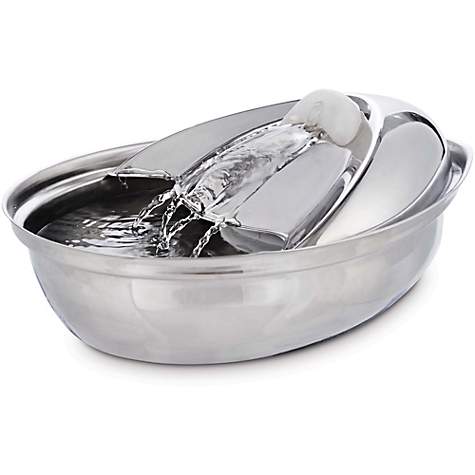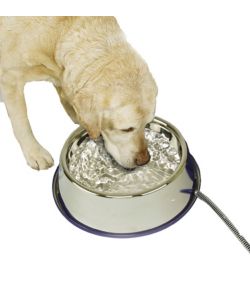What does your dog drink?
Most dogs would be completely happy to drink from the toilet to our dismay. If you allow your dog this "luxury" be very careful what is used in the tank or the products you use to clean the toilet. Toilets are full of bacteria, and require strong and toxic chemicals to clean them. Even if you think it's rinsed well...there may be a residue of toxic chemicals still left on the porcelin. If there's even a chance that the dog could drink from the toilet "accidentally" (someone left the lid up) it's better to be safe than sorry - don't use ANY in the tank cleaners except perhaps white vinegar or something safe and non-toxic. Just because it doesn't say it's toxic to pets doesn't mean it's not. Also, Malamutes are notorious for finding the toilet that wasn't flushed and having a field day with the contents. I won't go into the details here...but you get the picture. Better to train all the humans to shut the lid! It's much better to not use a toilet as your dog's water bowl! Another danger to all of us is Flouride in the water. In a total change of tune, health officials admitted there is too much flouride in the water. It can have detrimental effects on children and adults, so it will also affect your dog as well. They've discovered high fluoride levels in the body can induce genetic damage and cancer. (source: Flouridealert.org). So if you filter your water, you'll want to filter the dog's water too. Get that chlorene and fluoride out of there!
Speaking of dangerous things in water...don't give your dog alcohol or beer. Dr. Steve Hansen, a veterinary toxicologist and director of the ASPCA Animal Poison Center, Urbana, IL, says, "The primary reasons we don't want pets drinking alcohol is that their bodies aren't adjusted to it. And if they over-indulge, they may lose balance and fall from a counter or down stairs." Alcohol poisoning occurs if a dog drinks between 5 and 8 ml of alcohol per kilo bodyweight. That’s not ml of whiskey or wine, it’s ml of alcohol. Whiskey may contain up to 70% alcohol, which means that in a 30ml “nip", there’s 21 ml of actual alcohol. That’s more than enough to cause severe poisoning in a small dog. Wine contains around 10% alcohol and beer around 5% alcohol. Symptoms of alcohol poisoning are quite vague, as they can be characteristic of a number of illnesses, however your dog will possibly smell like alcohol. Symptoms develop within an hour, depending on how much food is in the stomach, and are similar to those of a drunk person - wobbly on the feet, sluggish responses, and either excitement or depression. Your dog can remain in this condition for a day or two. Too much and this develops into slow breathing, possibly coma and cardiac arrest, or heart attack. Treatment is supportive and non specific - activated charcoal can prevent absorption of more alcohol, and an intravenous drip re hydrates your dog and encourages the metabolism and excretion of the alcohol. If your dog is treated early, the outcome is usually good. But regardless, a taste of beer is one thing...but keep him away from the jello shots.
While most people feel water is not that big an issue, I think you'll agree you wouldn't want your dog drinking algae or debris filled water - and fluoride and chemicals are just as bad or worse. Dogs should have access at all times to fresh, clean and preferably cool water. Because a dog cannot "sweat" except through his mouth, it's important that the water he drinks in summer be cooling and not warm. Drinking helps him to regulate his body temperature on hot days. If you have well water - know what's in it. Some wells have high levels of certain minerals and you may need to filter out say, calcium to prevent kidney stones. Often well water uses a softener - but that adds a lot of excess salt to the dog's diet (which he is probably already getting in his dog food and treats).
Some tips for providing safe water for your Malamute:
1) Use faucet water filter for your dog's water that filters out both chlorine and fluoride.
2) Avoid distilled water or water treated with reverse osmosis, as it lacks beneficial minerals and nutrients needed by the body.
3) Never reuse plastic water bottles for your dog's water, the bottles can leach dangerous chemicals into the water. Purchase safe reusable water/beverage bottles - stainless steel whenever possible.
4) Provide your dog with a stainless steel water fountain to encourage more drinking of fresh, filtered water; which can discourage them from drinking from potentially harmful sources like mud puddles and lakes.
5) Replace plastic dog bowls with stainless steel to further prevent plastics from leaching.
6) Keep your dog's water bowl full and clean at all times and provide water often. Clean the bowls daily with something safe like vinegar. I like using a Mr. Clean Magic Eraser...no chemicals and it gets that film of dog slobber off easily!
7) Don't allow your pup to drink out of potentially harmful ponds, streams, rivers or puddles to avoid contamination with unhealthy bacteria and viruses.
8) Talk to your lawn care people. Most lawn care companies use some nasty chemicals. Dogs have died from just being nearby when they were spraying! Utilize safe lawn care practices, organic and all natural fertilizers, and avoid areas in parks or neighbor's yards that may have been sprayed recently.
9) Don't let your Malamute swim in chlorinated pools, or stagnant contaminated rivers, streams or ponds. Parasites and bacteria can be a concern.
10) Don't allow your dog to drink out of public or shared dog water bowls. Some diseases can be spread from dog to dog this way - ie: Parvo
11) Get a filtered bath/shower head for your dog's bathing area. Utilize environmentally friendly shampoos, conditioners, cleaning products, laundry detergents, non-chlorine stain removers and other items to keep your water cleaner in your community, around your dog and you
12) While most dogs love playing in the water from the garden hose or even swimming in pools...keep that kind of drinking to a minimum (though we admit they love it and so do we!). One of the dangers is "water intoxification" which is lethal - plus the combination of leaching plastic, chlorine and fluoride is not all that good overall for his health.
13) When you travel or hike, bring a simple water filter. That way if he needs a drink and the only water fountain is a stream - you're able to give him a safe alternative.
14) Avoid letting dogs drink standing water or water that is obviously not fresh or has insects in it. If possible, bring water for yourself and your dog to the dog gathering.
As a side note - some dogs actually can become "addicted" to excessive amounts of water. They will drink until they almost explode (water intoxification). You'll sometimes see this with puppies - some are just water-o-haulics and just don't know when to stop. If you have a dog like this, you may have to limit his water. Most large dogs drink between a quart to a gallon a day. We use individual buckets so we can monitor what each dog is drinking - to make sure they get enough - and also for the water-o-haulics. If you're having trouble "potty-training" pay attention to how much water the puppy is drinking. Some just drink and pee, drink and pee, to the point of craziness! In those cases you may have to dole out the water to about 1/2-1" in the bowl several times a day. If a dog's water intake changes, particularly if it increases dramatically (and it's not just warm weather) there may be underlying issues such as a bladder infection, an intestinal blockage, or diabetes and you'll want to get him to the vet to find out why. Most dogs are fairly consistent about what they drink day to day. For example, Theo is our water-o-haulic, yet Mula hardly drinks much at all....
Water is as individual as dogs are! Just make sure they always have an adequate amount of safe, clean water and pay attention to how much they drink - it could be an early warning sign of illness long before you notice any other symptoms.
















